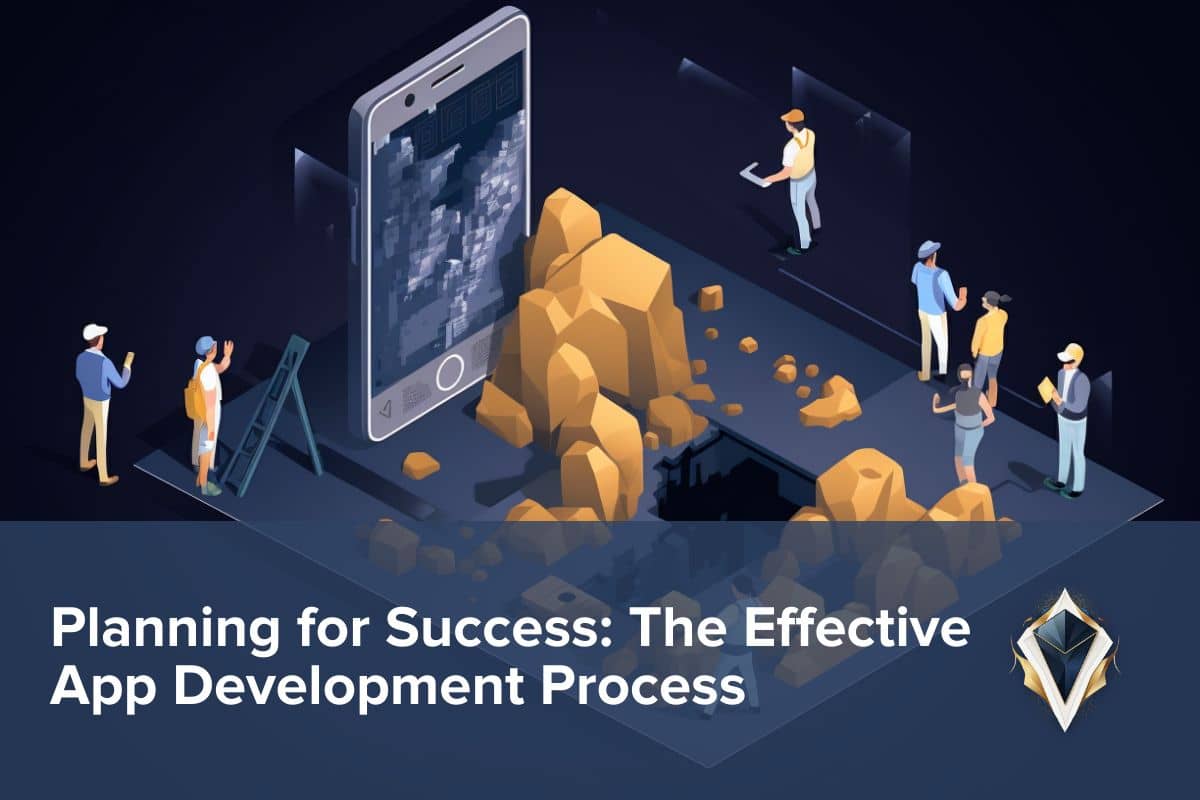In an increasingly digital world, mobile apps have become crucial platforms for businesses to interact with consumers. The success of these apps isn’t a happy accident, but the result of meticulous planning and strategic execution. Planning the app development process isn’t only about coding or deciding on the layout but involves understanding user preferences, defining clear goals, and integrating advanced technologies.
The correlation between a well-designed app and business success is undeniable. A seamless, user-friendly app can significantly enhance customer satisfaction and loyalty, boost brand visibility, and ultimately, drive revenue growth. Consequently, planning your app design flawlessly becomes a business imperative, rather than a mere choice.
This guide will walk you through each step of the app development process, from understanding your users to creating a comprehensive marketing and launch strategy. Use this as a roadmap to navigate the complex process of app design, and you’ll be well on your way to creating a successful app.
Check out our other blog post A Step-by-Step Guide to Successful FlutterFlow App Development for a more detailed step-by-step guide for FlutterFlow.
Understand Your Users
The first step in the app development process is understanding your target users. Before diving into the design and development phase, it is crucial to understand your target users intimately. They are, after all, the ones who will ultimately decide the success or failure of your app. What are their needs and preferences? What kind of experience are they looking for when using your app? The answers to these questions will serve as the foundation for your app design.
Conducting thorough user research is an excellent way to gain these insights. This can be done using various methods such as online surveys, interviews, or focus groups. A mix of these methods will help ensure you get a comprehensive understanding of your user base.
Once you have a wealth of user data, it’s time to create user personas. These are fictional representations of your potential users, typically based on the data you’ve collected. Personas can help your team understand and empathize with the users for whom you are designing. They can guide decision-making about product features, navigation, interactions, and even visual design. Thus, understanding your users forms the cornerstone of an effective app planning process.
Define Your App’s Purpose and Goals
Now that you have a clear understanding of your users, it’s time to define what your app aims to achieve. This starts with crafting a succinct and clear mission statement, a core guide that reflects the purpose of your app. It should answer the question, “Why does our app exist?” This not only gives direction to your team but also communicates the value of your app to potential users.
Next, set specific, measurable, attainable, relevant, and time-bound (SMART) goals for your app. These could range from acquiring a certain number of users within the first month of launch, achieving a specified user retention rate, or reaching a certain level of revenue within the first quarter.
Finally, identify your app’s Unique Selling Proposition (USP) – the features or qualities that make your app stand out from the crowd. This could be anything from a unique functionality, outstanding design, or superior user experience. Understanding your USP is crucial to position your app effectively in a highly competitive market.
In essence, defining your app’s purpose and goals will serve as the guiding light for all design and development efforts moving forward.
Conducting Market Research
An in-depth market analysis is crucial in the app development process. Understanding your market landscape is as crucial as understanding your users. An in-depth market analysis will help you gauge the competitive environment, identify market trends, and spot opportunities that your app could potentially exploit.
Start by analyzing your direct competitors. What are their strengths and weaknesses? What features do their apps offer? How do users perceive their apps? These insights can help you identify what you need to do to stand out.
Identifying gaps in the market is another vital component of market research. Are there needs or desires that are currently unfulfilled by existing apps? Are there customer pain points that your app can solve? By answering these questions, you can position your app as a unique solution in the marketplace.
Your market research will not only inform the direction of your app design but will also provide valuable insights for your marketing strategy. It ensures that your app is designed with a clear understanding of the market context, increasing the likelihood of its success.
Planning the User Experience (UX)

UX plays a critical role in the app development process. UX determines whether users will enjoy your app and keep coming back to it. It is essentially about creating a seamless, intuitive, and enjoyable journey for your users within your app.
Begin by crafting user journeys and flowcharts. These tools help visualize the path a user would follow to complete tasks within your app. They allow you to identify potential roadblocks or bottlenecks that could hinder the user’s experience.
Intuitive design and easy navigation are also key aspects of a great UX. Your users should be able to navigate your app easily and accomplish their goals without frustration. Good UX design minimizes learning curves and makes your app feel familiar and comfortable to new users.
Remember, a well-planned UX can result in increased user satisfaction and retention. So, invest time in understanding and mapping out the user experience for your app, considering each interaction the user will have from the moment they download your app to when they become loyal users.
Designing the User Interface (UI)
The User Interface (UI) is where your app’s users will interact with your software. A good UI design not only makes your app visually appealing but also enhances its overall usability, influencing user satisfaction and engagement.
Choosing the right color scheme, typography, and iconography is an important aspect of UI design. Colors can convey emotions and guide users’ actions, typography can affect readability and user comprehension, and well-designed icons can guide users intuitively through your app’s functionalities.
Another critical factor to consider is accessibility. Your app should be accessible to all potential users, including those with disabilities. This can involve ensuring that your app is usable for individuals with color blindness or impaired vision, incorporating voice-command features, and making sure your app is navigable using assistive devices.
Lastly, maintaining consistency in UI elements such as buttons, icons, and fonts across the app is key to avoid confusing your users. When users know what to expect, they’ll find the app easier to use, leading to a better overall experience.
To sum up, a well-designed UI not only enhances the look of your app but also significantly improves its functionality, making it easier for users to interact with and enjoy.
Incorporating Innovative Technologies
To truly make your app stand out and deliver exceptional value to your users, consider leveraging the power of cutting-edge technologies. These can offer a significant competitive edge, enhance the overall user experience, and make your app more efficient and user-friendly.
Artificial Intelligence (AI) can be used in various ways, such as personalizing user experiences, making smart recommendations, or enhancing search functionalities. Augmented Reality (AR) and Virtual Reality (VR) can create immersive experiences that elevate user engagement and satisfaction. Blockchain technology can be used to ensure secure transactions, especially useful for apps dealing with sensitive data or financial transactions.
However, it’s important to remember that technology for the sake of technology doesn’t necessarily result in a better app. The technology you choose to incorporate should align with your app’s purpose and goals, enhance your users’ experience, and offer real value.
By integrating the right technologies, you can push the boundaries of what your app can offer and keep your users coming back for more.
Prototyping and User Testing
Prototyping and user testing are critical steps in the app development process. Once you’ve outlined the fundamental design and features of your app, it’s time to bring it to life through a prototype. Prototypes are interactive models of your app that give you a ‘real’ look and feel of the end product.
Prototyping tools like Figma or Adobe XD can help you construct a working model of your app. These tools allow you to experiment with different designs, functionalities, and user flows, helping you refine your app before moving into full-scale development.
Once your prototype is ready, user testing is the next critical step. This involves real users interacting with your prototype and providing feedback on its usability, functionality, and overall experience. Their inputs can provide invaluable insights into how your app will be received by your target audience and highlight any potential issues or improvements.
Remember, the goal of prototyping and user testing is to iterate and improve. Based on user feedback and testing results, you’ll likely need to revise and refine your design multiple times. This process of continual refinement is key to creating an app that truly resonates with your users and delivers a remarkable experience.
Creating a Marketing and Launch Plan

No matter how great your app is, without effective marketing and a strategic launch plan, it might go unnoticed in the crowded app marketplace. Hence, devising a comprehensive marketing and launch strategy is crucial to ensure your app gets the attention it deserves.
Pre-launch marketing is all about building anticipation and creating buzz around your app before it hits the app stores. This can be done through social media campaigns, teaser videos, blog posts, email marketing, and more. The key here is to pique potential users’ interest and get them excited about your upcoming app.
When it comes to the launch, ensure your app is optimized for app stores (App Store for iOS, Google Play for Android). App store optimization (ASO) involves using relevant keywords in your app description, choosing the right app name, and using eye-catching app icons and screenshots.
Post-launch, continue your marketing efforts to maintain momentum. Engage with users on social media, encourage reviews and ratings, and consider using paid advertising to reach a wider audience.
Planning your marketing and launch meticulously can significantly increase your app’s visibility, drive downloads, and ultimately contribute to your app’s success.
Ensuring Continuous Improvement
The launch of your app is just the beginning. To ensure the longevity of your app’s success, you must adopt a mindset of continuous improvement. Your app should evolve based on user feedback, changing user needs, and emerging technology trends.
One of the most effective ways to understand user behavior and preferences is by using analytics. Using a tool like Google Analytics can help you track user engagement, identify features that are most liked or disliked, track crashes, and much more.
Regularly update your app based on the insights derived from these analytics. These updates could be in the form of new features, bug fixes, design improvements, or performance enhancements.
It’s also important to handle user feedback and complaints efficiently. Ensure that you have a system in place to collect, analyze, and act on user feedback. Users appreciate when their feedback is taken seriously and it helps build trust and loyalty.
Remember, the app market is highly dynamic, and users’ expectations keep evolving. To stay relevant and successful, your app must adapt and improve continually. This cycle of feedback, analysis, and improvement will help keep your app at the top of its game.
Planning for Success: The App Development Process Conclusion
The app development process involves a comprehensive plan, from understanding your users to continuously improving post-launch. It’s about defining clear goals, conducting thorough market research, delivering an exceptional user experience, and leveraging innovative technologies. Not to mention, the importance of a well-crafted marketing and launch strategy to ensure your app gets the visibility it deserves.
While it might seem like a daunting task, remember that the most successful apps are those that are user-centric, offer unique value, and are always ready to adapt and improve. Use this guide as a roadmap to navigate the complex yet exciting journey of planning your app. With the right approach, you’ll be well on your way to creating an app that not only you’re proud of but also loved by users.
Found this guide helpful? Feel free to share it with others who might benefit from it. We invite comments, suggestions, and discussions from all our readers. If you’ve had experiences planning an app or have any queries, we’d love to hear from you in the comments section below. Let’s learn, grow, and create amazing apps together!





0 Comments